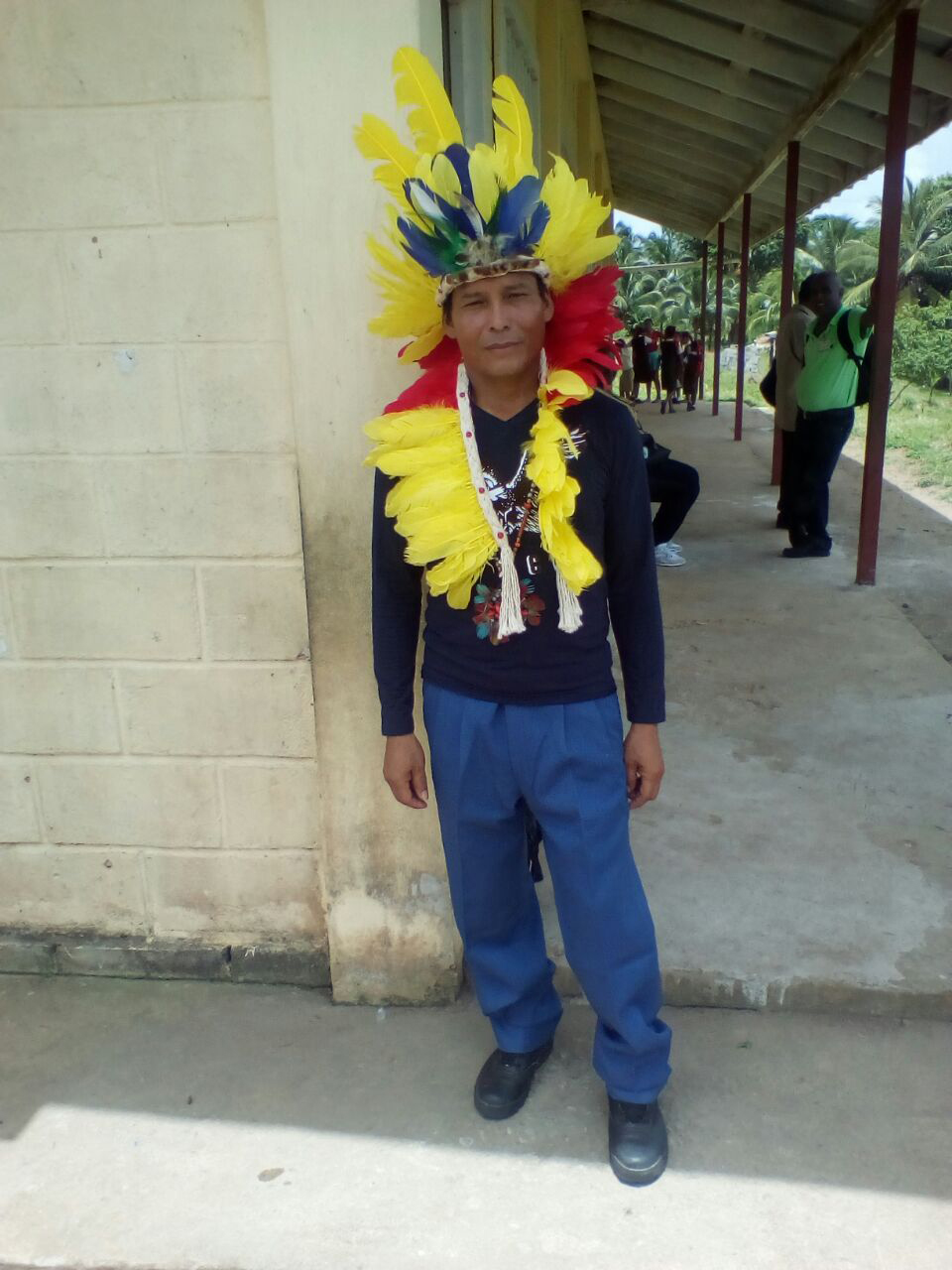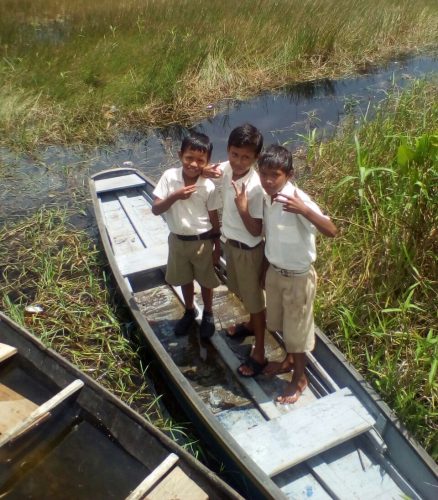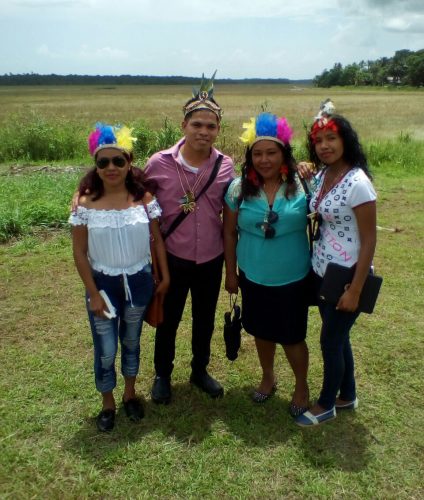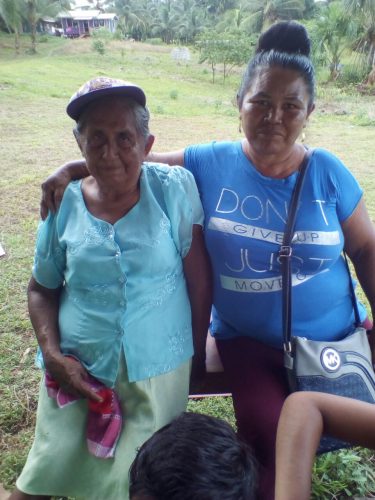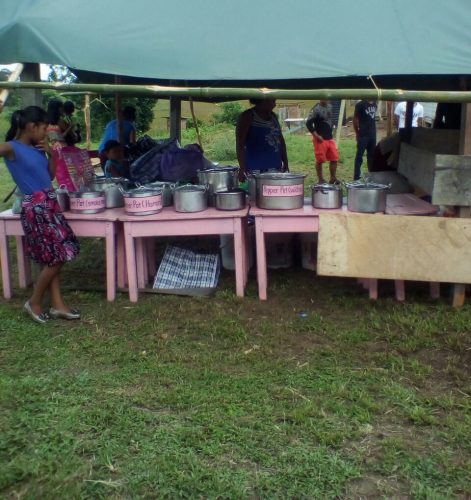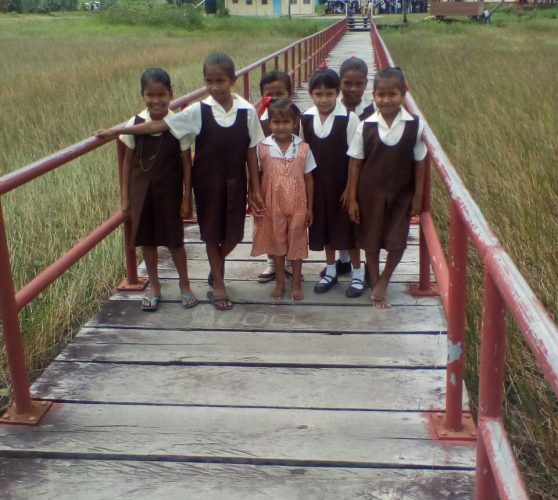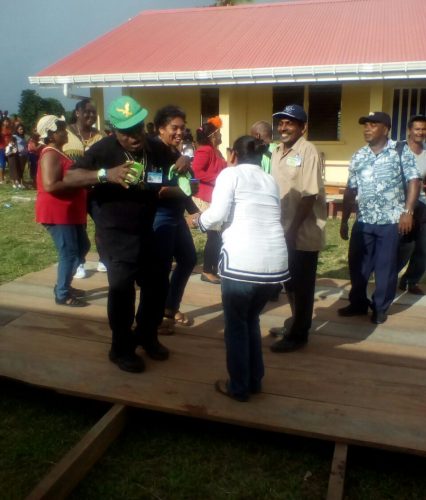Located 60 to 70 miles from Charity in the Lower Pomeroon River sits the pristine Amerindian Com-munity of Akawini, home to native Caribs, Warraus and Arawaks.
The village on Wednesday last held its annual Heritage Celebrations in grand style on the island of Barakaro and persons from as far as East Bank Demerara were in attendance. To get to Akawini, one has to endure a boat ride for some two to three hours down the Pomeroon River then into the Akawini Creek, but the long distance seemed short, as the scenery and quietness of the Pomeroon River gave a sense of tranquility.
The celebrations kicked off just after 2:00pm with a cultural presentation organized by the community. Traditional foods, drinks, art and craft were on display and for sale at the event.
The Amerindian culture was indeed celebrated as persons gyrated to folk songs and ate traditional dishes such as Fish Pepper-pot, Smoked meat Pepper-pot, Haimara [sweet water fish] Pepperpot, Wild Hog Pepperpot, Lukanani Pepperpot and Labba Pepperpot. Local drinks on display included such favourites as Fly (potato drink), Bambali, Casseri, Piwari and Corn wine.
Persons had the opportunity to take part in games and competitions which included archery, tug-of-war, bird naming, animal naming and Fly drinking.
The name Akawini is an Arawak name which is broken into two, as explained by Toshao David Wilson. ‘Akya’ being a tree which is seen along the banks of the creek which leads into the community, and ‘Wini’ which signifies the many turns one has to go through in the creek to reach any one of the islands located there.
Akawini is divided into four sections; Front View, School Island, Ykinipa and Barakaro and is home to some 1,200 people. The community has one Primary School, a Primary Annex, Nursery School and a Health Centre.
Speaking with Stabroek News, Toshao Wilson spoke of the many difficulties faced by the Akawini Village, one of the most important being the shortage of trained teachers in the community.
Presently, there are only two trained teachers which according to Wilson leads to the underperformance of students since teachers are tasked with having to teach three different levels of classes at the same time.
“At this year’s Common Entrance Examination, twenty seven students wrote but only seven goes to school. That means twenty are not going to school. The main reason is because parents cannot afford it, or they do go to school sometimes for only two weeks, and most times the girls who would have to stay in the dorms start behaving strange and their parents take them out of school and are afraid to send them back so they are just at home.
Main plea
“But it still goes back to us not having enough teachers. Right now the main plea to the government is to send teachers here. Our children can do well but they need the qualified persons to help and guide them. When the president [Granger] was here in 2015 I made a proposal to him to start a secondary class which would avoid children from having to travel way out on the coast to attend school or those who are of age would not have to sit at home and do nothing. We are still waiting to see the secondary class implemented because I think that is very important.”
Children from the community usually attend the Wakapoa Secondary, Eighth of May Secondary, Cotton Field Secondary and Anna Regina Secondary Schools.
Asked about how his community is living up to the theme of this year’s Amerindian Heritage Month ‘Guyana’s First People Maintaining a Rich Cultural Environment’, Wilson was eager to share his thoughts.
“From the time I’ve become a leader of this village in 2001, I believe that preserving our culture is one of the things that kept us strong and kept us alive. We never find ourselves destroying our environment. We always have a clean environment. Our natural resources are always there and we never over harvest our forest at all. Even before the Guyana Forestry put in restrictions that we should only cut certain diameter of trees, our council had already put that in place. When we talked about protecting the area, although we had no talks with the government, as a council we felt that using these forests would make our resources be done away with. So as a council we decided to put away part of our forest as a protected area. We did this because we feel when our little children and our grand and great grandchildren come up, they would never know what is a purpleheart tree or any of the other trees. We decided that when our children grow up, we can take them to the area and tell them about the protected trees. Our culture is being protected by the older folks and we have to keep that going.”
Wilson commented that members of his village once had a habit of poisoning the creek when the water was low which would have allowed them to catch a great number of fish. However, this, he said, has been now been restricted.
“We realize that when you poison the creek in the low water it would kill everything, so we do not poison anymore but instead do what we call traditional fishing or traditional trapping of fish. We only catch what the family would utilize using a rod and a hook and that’s it. We use to have people from the Pomeroon River and the coast coming in here and setting miles of seine and they used to catch mainly Hassar fishes and the other fishes like Patwa. They used to take them out of the seine and leave them by bundles by the edge of the creek and we felt that was wasting the fish. Because of that we stopped all seine catching of fish and banned people from coming here to do that and we warned our people not to indulge in trapping the fish by seine. Any of our people caught doing that has to come and do community work because we are preserving our resources for the future generation.
“This restriction is indeed working because today, if you come to Akawini when the water is low, you will be able to collect fishes by the handful, because they go up on the grass because they are so much and you can go with a … strainer and collect more than six fishes at once. When that season comes around because of the abundance of the fishes, we would call people from the Pomeroon to collect them, because we find if we don’t call people to collect, the creek would be polluted with the dead fishes.”
The language of the native Amerindians is one which is hardly spoken, but when it is spoken, it certainly is pleasurable to hear.
79 year old Ethel Tobin of the Carib Nation is one such native who speaks fluent Carib dialect.
Tobin who was sitting along with a friend awaiting the start of the celebrations said that it is her desire to see more youths learning the language.
“It have other people who speak the language but they don’t know it all, but at least they can understand certain things that we say when we speak that way. I think that more young people should learn to speak it too, so that when they get old they can teach their children,” the septuagenarian opined.
According to Toshao Wilson, it is the will of the community council to have the language included in the school curriculum so that the youths can be able to learn the dialect, in an effort to preserve the culture.
Curriculum
“We made a request for the language to be included in the curriculum, because this is how we will preserve it. The older folks know the language, so we had said that we would ask them to teach our youths. We had also said that we would want to pay them because we just can’t pressure someone to teach the language in school without paying them,” the village leader shared.
Wilson also noted that arts and craft are done by villagers, but the culture seems to be slowly dying away. However, efforts are being made to have them done on a large scale, since most of the materials needed are readily accessible by villagers. The problem of finding sustainable markets for the art and crafts still remains an issue, therefore, suitable markets must be sought before the villagers can produce such items on a large scale.
Ecotourism is now next on the list for the community of Akawini because the pristine, raw jungle has much to offer to nature lovers. Only two percent of the community is cultivated land. The rest is filled with wildlife, lush rainforest and open savannahs with fertile agricultural lands. There is a variety of fish that can be caught in the pure black water, tropical flowering plants, vines and fruit trees and numerous species of tropical birds can be seen. Wilson said that there are even two nests of the magnificent Harpy Eagles.
“We are working with Adel’s Resort located right here in Akawini, in an effort to promote tourism. The resort is located at the mouth of the Akawini Creek which provides accommodation for persons who would like to visit the Pomeroon River and more so, Akawini. We are looking to buy things from our villagers such as hammocks, chairs, native clothing and whatever else they make, and we plan to display them at the Adel’s Resort, so whenever foreigners come there, they will be able to purchase them,” Wilson said.
Dazzling
Adel’s Resort offers nature walks which are led by the local indigenous people, bird watching sessions, and a butterfly safari where you can walk through the forest and photograph the dazzling butterflies that adorn the route. These experiences are provided by the resort which collaborates with the Akawini Village Council, as well as, the neighbouring Amer-indian community of Wakapoa.
An ecotourism lodge is also set to be built in the near future in Akawini where persons would have the chance to experience the exotic paradise for themselves. The material to build the lodge is presently being sourced so that it can be constructed as early as possible.
Even though villagers are involved in farming and fishing in the community to provide for their personal needs, the main economic activity is part time lumbering. Fishing and farming can be done on a large scale, but according to Wilson, there is no market for such activities.
On the School Island and on Barakaro, there are two hot-meal kitchens- a government initiative which provides hot meals each day for children attending school. The hot meal kitchens were built by the Council of Akawini and part of the funds was provided by the Ministry of Indi-genous Peoples’ Affairs. The women who usually cook on a daily basis are community members and are given a stipend each month. This activity provides a means of employment for the community.
Being almost 70 miles away from the nearest hospital at Charity, villagers have full access to the Community Health Post on Barakaro and the Health Centre on the School Island. Even though there are many gaps in the health system, the midwife along with the Community Health workers stationed at the centres provide the best possible care available to the community.
Babies of first-time mothers are usually delivered at the Suddie Hospital on the Essequibo Coast, but the second or third child is delivered at the Health Centre in the community.
Electricity is provided by small solar systems which can power two bulbs, and were implemented in 2011 when the government introduced the Household Lighting System. However the solar system batteries are said to be old and need replacing.
Regional Vice Chairman Juliet Coonjah along with other regional administration councillors were present at the event which was dubbed “a huge success”.
In her remarks, Coonjah indicated the readiness of the Regional Democratic Council in dealing with issues that are affecting community members and promised to make full representations for the community.
The cultural celebration activities went late into Wednesday night as the heritage of the Amerindians was celebrated by one and all.
